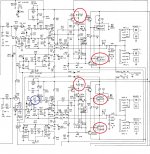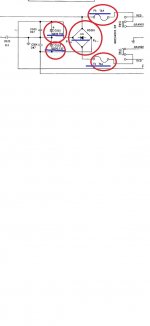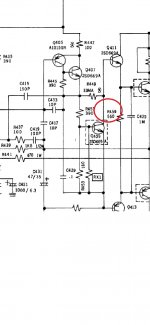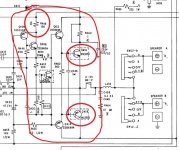Afternoon.
i picked up a damaged nad 3130 recently and decided to repair it as i have a good front cover spare.
in the pictures you will see circled in red the parts i replaced as they were all faulty, the 2 resistors were scorched,but the resistances seemed ok.
the rectifier was faulty-replaced with an 8amp unit
the 2 no T4a fuses were blown-replaced
the 2 no power caps were replaced with new ones
Q 418,417 and 416 were all faulty,Q 415 was only showing a reading of 3.5v so i replaced that as well
the 2 scorched resistors were replaced
now i finished doing this about 10am and have had it on since,using all the outputs, then all of a sudden the sound on one channel started getting very distorted and then i heard the resitor burn out, so i turned off straight away and opened it up to fine R412 totaly killed, but fuses still in tact.i couldnt see anything else visualy that looked burned.
im thinking over current? but at the moment ive not looked at it and proberbly wont get a chance untill next week now, so i wondered if you guys had any thoughts.
i picked up a damaged nad 3130 recently and decided to repair it as i have a good front cover spare.
in the pictures you will see circled in red the parts i replaced as they were all faulty, the 2 resistors were scorched,but the resistances seemed ok.
the rectifier was faulty-replaced with an 8amp unit
the 2 no T4a fuses were blown-replaced
the 2 no power caps were replaced with new ones
Q 418,417 and 416 were all faulty,Q 415 was only showing a reading of 3.5v so i replaced that as well
the 2 scorched resistors were replaced
now i finished doing this about 10am and have had it on since,using all the outputs, then all of a sudden the sound on one channel started getting very distorted and then i heard the resitor burn out, so i turned off straight away and opened it up to fine R412 totaly killed, but fuses still in tact.i couldnt see anything else visualy that looked burned.
im thinking over current? but at the moment ive not looked at it and proberbly wont get a chance untill next week now, so i wondered if you guys had any thoughts.
Attachments
Thoughts...
While it is not impossible for a 22k to fail I can not see how it could scorch. The reason for saying that is this... a 22k 0.25w (so a small wattage) can withstand 75 volts across it.
It would need a pretty obscure failure mode to get close to that (the full rail to rail voltage is the most it could see whatever that is) and I can't really see any conceivable fault that could give that.
Are you sure it is R412?
While it is not impossible for a 22k to fail I can not see how it could scorch. The reason for saying that is this... a 22k 0.25w (so a small wattage) can withstand 75 volts across it.
It would need a pretty obscure failure mode to get close to that (the full rail to rail voltage is the most it could see whatever that is) and I can't really see any conceivable fault that could give that.
Are you sure it is R412?
i will double check as i couldnt see the writing on the PCB,but this board has a mirror image of each channel so i assumed it was its opposite to R411
🙂 so R459 should never see any significant voltage across it. For it to burn implies that either the output transistors (one of them) has gone open circuit or that there is a problem with the driver stages.
Knowing the 2DS669 and 2SB649 types and how they can become intermittently faulty I would suggest replacing these along with Q407 before the drivers. Q407 probably runs quite hot in normal use. Also check for dries on the two 1k2 resistors R455 and R457 and if they look discoloured then replace them. They will run hot. I would also replace Q409 which is the vbe multiplier.
Although it is always better to actually measure voltage under fault conditions, the fact these 2SD/2SB devices can give trouble means that in this instance I would simply replace them.
Output transistors usually fail permanently, they don't usually have intermittent issues. If you are happy with those then you can leave them in place.
Turn the bias to minimum before powering on and use the bulb tester initially to make sure all is well.
Knowing the 2DS669 and 2SB649 types and how they can become intermittently faulty I would suggest replacing these along with Q407 before the drivers. Q407 probably runs quite hot in normal use. Also check for dries on the two 1k2 resistors R455 and R457 and if they look discoloured then replace them. They will run hot. I would also replace Q409 which is the vbe multiplier.
Although it is always better to actually measure voltage under fault conditions, the fact these 2SD/2SB devices can give trouble means that in this instance I would simply replace them.
Output transistors usually fail permanently, they don't usually have intermittent issues. If you are happy with those then you can leave them in place.
Turn the bias to minimum before powering on and use the bulb tester initially to make sure all is well.
I see turning the bias down is easier said than done as this amp uses fixed resistors selected on test. I would fit a preset initially, get the bias correct with any new parts and then take the preset out and measure it and fit a suitable set of fixed resistors.
R411,R412 consume around 0.05va power,
after a long long time the resistors could deteriorate and change its value slowly.
better change them all.
suggest change R447, R448 also.
it is necessary to check the value of the adjacent resistors.
also good to check the solder joints, pads, etc.
after a long long time the resistors could deteriorate and change its value slowly.
better change them all.
suggest change R447, R448 also.
it is necessary to check the value of the adjacent resistors.
also good to check the solder joints, pads, etc.
so it is actualy the other channel that is faulty, i was just looking at the top of the diagram, same components though just the opposite channel
bit of a mess actualy
so far R460-shot
R458-ok
R456-ok
Q408-ok
Q410-shot
Q412-shot
Q416-shot
Q414-shot
Q418-shot
thats as far as i have got.
i dont have any 2N3055, i have the rest so ill have to get that one first before i can go any further, unless there is anything else i can check in the meantime
bit of a mess actualy
so far R460-shot
R458-ok
R456-ok
Q408-ok
Q410-shot
Q412-shot
Q416-shot
Q414-shot
Q418-shot
thats as far as i have got.
i dont have any 2N3055, i have the rest so ill have to get that one first before i can go any further, unless there is anything else i can check in the meantime
You have to check as much as possible around the output stage using basic passive testing (resistance checks) and then rebuild the stage and use the bulb tester to continue fault finding.
I'm surprised Q410 would be faulty (bias generator). You must check all these out of circuit to get reliable results.
Usually most faults are down to output and drivers and sometimes the next stage back gets taken out as well... so Q406 and Q408.
I'm surprised Q410 would be faulty (bias generator). You must check all these out of circuit to get reliable results.
Usually most faults are down to output and drivers and sometimes the next stage back gets taken out as well... so Q406 and Q408.
ill carry on checking.
all items were removed for testing and i always use my trusty home made heatsink
all items were removed for testing and i always use my trusty home made heatsink
406 was blown 408 okYou have to check as much as possible around the output stage using basic passive testing (resistance checks) and then rebuild the stage and use the bulb tester to continue fault finding.
I'm surprised Q410 would be faulty (bias generator). You must check all these out of circuit to get reliable results.
Usually most faults are down to output and drivers and sometimes the next stage back gets taken out as well... so Q406 and Q408.
how much further would you go back? i cant do a bulb test yet untill i get the 2n3055
all resistors checked and are all within tolerence values, so i guess now i wait untill i get the 2n3055's as i had the others and replaced them, then ill do the bulb test.
i also noticed that one of the PCB grounding screws were missing, but that shouldnt have made alot of difference should it? as there are many others
i also noticed that one of the PCB grounding screws were missing, but that shouldnt have made alot of difference should it? as there are many others
Last edited:
Can not see the screw being an issue as regards the fault. It may or may not be needed to get the very lowest noise and hum from the amp (but probably not).
You must have spent a lot of time to check the components,
I am thinking, why not take this opportunity to change all the resistors etc.
It will be more reliable and the prices are very cheap.
and you can enjoy a long period of worry free entertainment in the future.
I am thinking, why not take this opportunity to change all the resistors etc.
It will be more reliable and the prices are very cheap.
and you can enjoy a long period of worry free entertainment in the future.
- Home
- Amplifiers
- Solid State
- NAD 3130 sudden resistor failure



